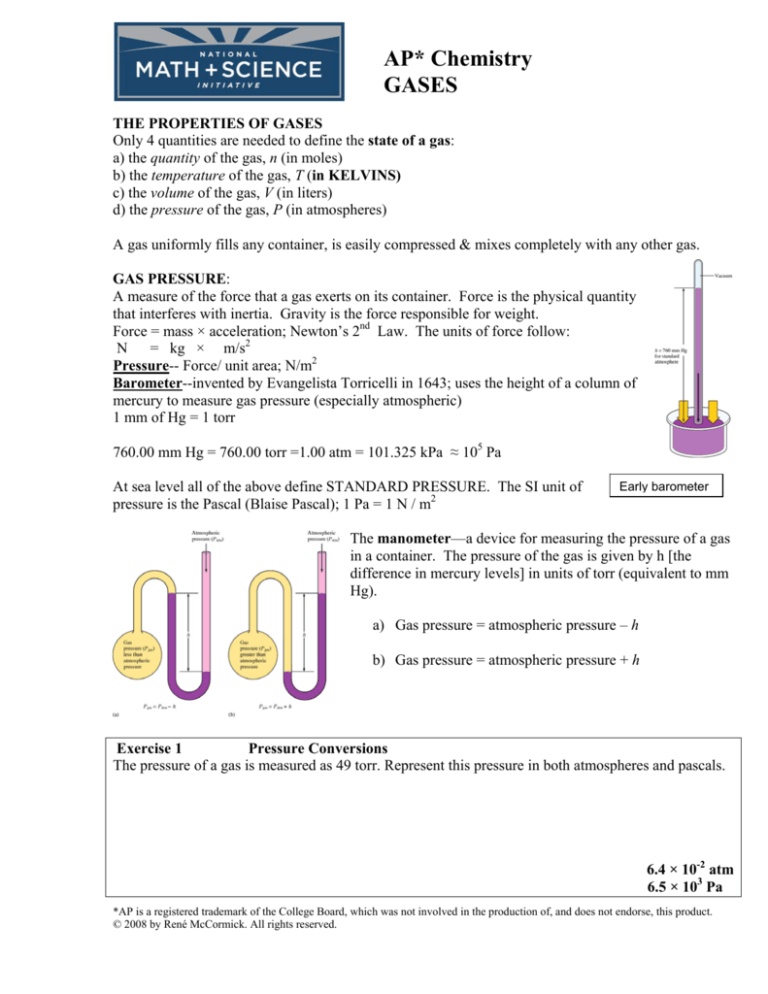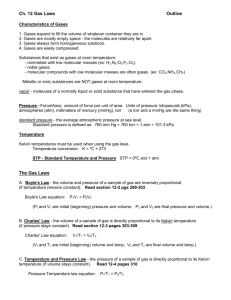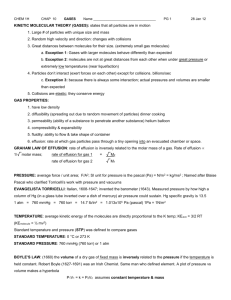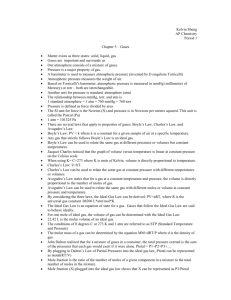
AP* Chemistry
GASES
THE PROPERTIES OF GASES
Only 4 quantities are needed to define the state of a gas:
a) the quantity of the gas, n (in moles)
b) the temperature of the gas, T (in KELVINS)
c) the volume of the gas, V (in liters)
d) the pressure of the gas, P (in atmospheres)
A gas uniformly fills any container, is easily compressed & mixes completely with any other gas.
GAS PRESSURE:
A measure of the force that a gas exerts on its container. Force is the physical quantity
that interferes with inertia. Gravity is the force responsible for weight.
Force = mass × acceleration; Newton’s 2nd Law. The units of force follow:
N
= kg × m/s2
Pressure-- Force/ unit area; N/m2
Barometer--invented by Evangelista Torricelli in 1643; uses the height of a column of
mercury to measure gas pressure (especially atmospheric)
1 mm of Hg = 1 torr
760.00 mm Hg = 760.00 torr =1.00 atm = 101.325 kPa ≈ 105 Pa
At sea level all of the above define STANDARD PRESSURE. The SI unit of
pressure is the Pascal (Blaise Pascal); 1 Pa = 1 N / m2
Early barometer
The manometer—a device for measuring the pressure of a gas
in a container. The pressure of the gas is given by h [the
difference in mercury levels] in units of torr (equivalent to mm
Hg).
a) Gas pressure = atmospheric pressure – h
b) Gas pressure = atmospheric pressure + h
Exercise 1
Pressure Conversions
The pressure of a gas is measured as 49 torr. Represent this pressure in both atmospheres and pascals.
6.4 × 10-2 atm
6.5 × 103 Pa
*AP is a registered trademark of the College Board, which was not involved in the production of, and does not endorse, this product.
© 2008 by René McCormick. All rights reserved.
Exercise
Rank the following pressures in decreasing order of magnitude (largest first, smallest last): 75 kPa,
300. torr, 0.60 atm and 350. mm Hg.
GAS LAWS: THE EXPERIMENTAL BASIS
• BOYLE’S LAW: “father of chemistry”--the volume of a confined gas is
inversely proportional to the pressure exerted on the gas. ALL GASES
BEHAVE IN THIS MANNER!
• Robert Boyle was an Irish chemist. He studied PV relationships using a Jtube set up in the multi-story entryway of his home.
o P ∝ 1/V
plot = straight line
o pressure and volume are inversely proportional
o Volume ↑ pressure ↓ at constant temperature, the converse is also
true
o for a given quantity of a gas at constant temperature, the product of
pressure and volume is a constant.
PV = k
k
1
Therefore, V = = k
P
P
which is the equation for a straight line of the type
y = mx + b where m = slope, and b the y-intercept
In this case, y = V, x = 1/P and b = 0. Check out the
plot on the right (b). The data Boyle collected is
graphed on (a) above.
o P1V1 = P2V2 is the easiest form of Boyle’s law to memorize
o Boyle’s Law has been tested for over three centuries. It holds true
only at low pressures.
A plot of PV versus P for several gases at pressures below 1atm is
pictured at left.
An ideal gas is expected to have a constant value of PV, as shown by the
dotted line. CO2 shows the largest change in PV, and this change is
actually quite small: PV changes from about 22.39 L·atm at 0.25 atm to
22.26 L·atm at 1.00 atm. Thus Boyle’s Law is a good approximation at
these relatively low pressures.
Gases
2
Exercise 2
Boyle’s Law I
Sulfur dioxide (SO2), a gas that plays a central role in the formation of acid rain, is found in the
exhaust of automobiles and power plants. Consider a 1.53- L sample of gaseous SO2 at a pressure of
5.6 × 103 Pa. If the pressure is changed to 1.5 × 104 Pa at a constant temperature, what will be the new
volume of the gas ?
0.57 L
Exercise 3
Boyle’s Law II
In a study to see how closely gaseous ammonia obeys Boyle’s law, several volume measurements
were made at various pressures, using 1.0 mol NH3 gas at a temperature of 0ºC. Using the results listed
below, calculate the Boyle’s law constant for NH3 at the various pressures.
Experiment
1
2
3
4
5
6
Pressure (atm)
0.1300
0.2500
0.3000
0.5000
0.7500
1.000
Volume (L)
172.1
89.28
74.35
44.49
29.55
22.08
experiment 1 is 22.37
experiment 2 is 22.32
experiment 3 is 22.31
experiment 4 is 22.25
experiment 5 is 22.16
experiment 6 is 22.08
PLOT the values of PV for the six experiments above.
Extrapolate it back to see what PV equals at 0.00 atm pressure.
Compare it to the PV vs. P graph on page 2 of these notes.
What is the y-intercept for all of these gases?
Remember, gases behave most ideally at low pressures. You can’t
get a pressure lower than 0.00 atm!
Gases
3
•
•
CHARLES’ LAW: If a given quantity of gas is held at a constant pressure, then its volume is
directly proportional to the absolute temperature. Must use KELVIN
Jacques Charles was a French physicist and the first person to fill a hot “air” balloon with
hydrogen gas and made the first solo balloon flight!
o V ∝ T plot = straight line
o V1T2 = V2T1
o Temperature ∝ Volume at constant pressure
o This figure shows the plots of V vs. T (Celsius) for several
gases. The solid lines represent experimental
measurements on gases. The dashed lines represent
extrapolation of the data into regions where these gases
would become liquids or solids. Note that the samples of
the various gases contain different numbers of moles.
o What is the temperature when the Volume extrapolates to
zero?
Exercise 4
Charles’s Law
A sample of gas at 15ºC and 1 atm has a volume of 2.58 L. What volume will this gas occupy at 38ºC
and 1 atm ?
2.79 L
•
•
GAY-LUSSAC’S LAW of combining volumes: volumes of
gases always combine with one another in the ratio of small whole
numbers, as long as volumes are measured at the same T and P.
- P1T2 = P2T1
- Avogadro=s hypothesis: equal volumes of gases under the
same conditions of temperature and pressure contain equal
numbers of molecules.
AVOGADRO’S LAW: The volume of a gas, at a given
temperature and pressure, is directly proportional to the
quantity of gas.
V∝n
-
n ∝ Volume at constant T & P
HERE’S AN EASY WAY TO MEMORIZE ALL OF THIS!
Start with the combined gas law:
These balloons each hold 1.0 L
of gas at 25°C and 1 atm. Each
balloon contains 0.041 mol of
gas, or 2.5 × 1022 molecules.
Gases
P1V1T2 = P2V2T1
Memorize it.
Next, put the fellas’ names in alphabetical order.
Boyle’s uses the first 2 variables, Charles’ the second 2 variables &
Gay-Lussac’s the remaining combination of variables. What ever
doesn’t appear in the formula, is being held CONSTANT!
4
Exercise 5
Avogadro’s Law
Suppose we have a 12.2-L sample containing 0.50 mol oxygen gas (O2) at a pressure of 1 atm and a
temperature of 25ºC. If all this O2 were converted to ozone (O3) at the same temperature and pressure,
what would be the volume of the ozone ?
8.1 L
THE IDEAL GAS LAW
Four quantities describe the state of a gas: pressure, volume, temperature, and # of moles (quantity).
Combine all 3 laws:
V ∝ nT
P
Replace the ∝ with a constant, R, and you get:
PV = nRT
The ideal gas law! It is an equation of state.
R = 0.8206 L• atm/mol • K also expressed as 0.8206 L atm mol−1 K−1
Useful only at low Pressures and high temperatures! Guaranteed points on the AP Exam!
These next exercises can all be solved with the ideal gas law, BUT, you can use another if you like!
Exercise 6
Ideal Gas Law I
A sample of hydrogen gas (H2) has a volume of 8.56 L at a temperature of 0ºC and a pressure of
1.5 atm. Calculate the moles of H2 molecules present in this gas sample.
0.57 mol
Exercise 7
Ideal Gas Law II
Suppose we have a sample of ammonia gas with a volume of 3.5 L at a pressure of 1.68 atm. The gas
is compressed to a volume of 1.35 L at a constant temperature. Use the ideal gas law to calculate the
final pressure.
4.4 atm
Gases
5
Exercise 8
Ideal Gas Law III
A sample of methane gas that has a volume of 3.8 L at 5ºC is heated to 86ºC at constant pressure.
Calculate its new volume.
4.9 L
Exercise 9
Ideal Gas Law IV
A sample of diborane gas (B2H6), a substance that bursts into flame when exposed to air, has a
pressure of 345 torr at a temperature of -15ºC and a volume of 3.48 L. If conditions are changed so
that the temperature is 36ºC and the pressure is 468 torr, what will be the volume of the sample?
3.07 L
Exercise 10
Ideal Gas Law V
A sample containing 0.35 mol argon gas at a temperature of 13ºC and a pressure of 568 torr is heated
to 56ºC and a pressure of 897 torr. Calculate the change in volume that occurs.
decreases by 3 L
GAS STOICHIOMETRY
Use PV = nRT to solve for the volume of one mole of gas at STP:
Look familiar? This is the molar volume of a gas at STP. Work stoichiometry problems using your
favorite method, dimensional analysis, mole map, the table way…just work FAST! Use the ideal gas
law to convert quantities that are NOT at STP.
Gases
6
Exercise 11
Gas Stoichiometry I
A sample of nitrogen gas has a volume of 1.75 L at STP. How many moles of N2 are present?
7.81 × 10-2 mol N2
Exercise 12
Gas Stoichiometry II
Quicklime (CaO) is produced by the thermal decomposition of calcium carbonate (CaCO3). Calculate
the volume of CO2 at STP produced from the decomposition of 152 g CaCO3 by the reaction
CaCO3(s) → CaO(s) + CO2(g)
34.1 L CO2 at STP
Exercise 13
Gas Stoichiometry III
A sample of methane gas having a volume of 2.80 L at 25ºC and 1.65 atm was mixed with a sample of
oxygen gas having a volume of 35.0 L at 31ºC and 1.25 atm. The mixture was then ignited to form
carbon dioxide and water. Calculate the volume of CO2 formed at a pressure of 2.50 atm and a
temperature of 125ºC.
2.47 L
Gases
7
THE DENSITY OF GASES:
d = m = P(MM) {for ONE mole of gas}= MM
V
RT
22.4 L
AND
Molar Mass = MM = dRT
P
“Molecular Mass kitty cat”—all good cats put dirt [dRT] over their pee [P]. Corny? Yep! But, you’ll
thank me later!
Just remember that densities of gases are reported in g/L NOT g/mL.
What is the approximate molar mass of air? _________
The density of air is approx. _______ g/L.
List 3 gases that float in air:
List 3 gases that sink in air:
Exercise 14
Gas Density/Molar Mass
The density of a gas was measured at 1.50 atm and 27ºC and found to be 1.95 g/L. Calculate the molar
mass of the gas.
32.0 g/mol
GAS MIXTURES AND PARTIAL PRESSURES
The pressure of a mixture of gases is the sum of the pressures of the different
components of the mixture:
Ptotal = P1 + P2 + . . . Pn
John Dalton’s Law of Partial Pressures also uses the concept of mole fraction, χ
χA =
so now,
moles of A
.
moles A + moles B + moles C + . . .
PA = χ A Ptotal
The partial pressure of each gas in a mixture of gases in a container depends on the
number of moles of that gas. The total pressure is the SUM of the partial pressures and
depends on the total moles of gas particles present, no matter what they are!
Gases
8
Exercise 15
Dalton’s Law I
Mixtures of helium and oxygen are used in scuba diving tanks to help prevent “the bends.” For a
particular dive, 46 L He at 25ºC and 1.0 atm and 12 L O2 at 25ºC and 1.0 atm were pumped into a tank
with a volume of 5.0 L. Calculate the partial pressure of each gas and the total pressure in the tank at
25ºC.
PHe = 9.3 atm
PO2 = 2.4 atm
PTOTAL = 11.7 atm
Exercise 16
Dalton’s Law II
The partial pressure of oxygen was observed to be 156 torr in air with a total atmospheric pressure of
743 torr. Calculate the mole fraction of O2 present.
0.210
Exercise 17
Dalton’s Law III
The mole fraction of nitrogen in the air is 0.7808. Calculate the partial pressure of N2 in air when the
atmospheric pressure is 760. torr.
593 torr
WATER DISPLACEMENT
It is common to collect a gas by water
displacement which means some of
the pressure is due to water vapor
collected as the gas was passing
through! You must correct for this.
You look up the partial pressure due to
water vapor by knowing the
temperature.
Gases
9
Exercise 8
Gas Collection over Water
A sample of solid potassium chlorate (KClO3) was
heated in a test tube (see the figure above) and
decomposed by the following reaction:
2 KClO3(s) → 2 KCl(s) + 3 O2(g)
The oxygen produced was collected by
displacement of water at 22ºC at a total pressure of
754 torr. The volume of the gas collected was 0.650 L, and the vapor pressure of water at 22ºC is 21
torr. Calculate the partial pressure of O2 in the gas collected and the mass of KClO3 in the sample that
was decomposed.
Partial pressure of O2 = 733 torr
2.12 g KClO3
KINETIC MOLECULAR THEORY OF GASES
Assumptions of the MODEL:
1.
2.
3.
4.
All particles are in constant, random, motion.
All collisions between particles are perfectly elastic.
The volume of the particles in a gas is negligible
The average kinetic energy of the molecules is its Kelvin temperature.
This neglects any intermolecular forces as well.
Gases expand to fill their container, solids/liquids do not.
Gases are compressible, solids/liquids are not appreciably compressible.
This helps explain Boyle’s Law:
If the volume is decreased that means that the gas
particles will hit the wall more often, thus increasing
pressure
1
P = (nRT )
V
Constant
Gases
10
And helps explain Charles’ Law
When a gas is heated, the speed of its particles increase and
thus hit the walls more often and with more force. The only
way to keep the P constant is to increase the volume of the
container.
⎛ nR ⎞
V = ⎜ ⎟T
⎝ P ⎠
Constant
And also helps explain Gay-Lussac’s Law
When the temperature of a gas increases, the speeds of its
particles increase, the particles are hitting the wall with
greater force and greater frequency. Since the volume
remains the same this would result in increased gas
pressure.
⎛ nR ⎞
P=⎜
⎟T
⎝V ⎠
Constant
And even helps explain Avogadro’s Law
An increase in the number of particles at the same
temperature would cause the pressure to increase if
the volume were held constant. The only way to
keep constant P is to vary the V.
⎛ RT ⎞
V =⎜
⎟n
P
⎝
⎠
Constant
What about Dalton’s Law? The P exerted by a mixture of gases is the SUM of the partial pressures
since gas particles are acting independent of each other and the volumes of the individual particles
DO NOT matter.
Gases
11
DISTRIBUTION OF MOLECULAR SPEEDS
Plot # of gas molecules having various speeds vs. the speed and you get a curve. Changing the
temperature affects the shape of the curve NOT the area beneath it. Change the # of molecules and all
bets are off!
Maxwell’s equation:
3RT
MM
Use the “energy R” or 8.314510 J/K• mol for this equation since kinetic energy is involved.
u 2 = urms =
Exercise 19
Root Mean Square Velocity
Calculate the root mean square velocity for the atoms in a sample of helium gas at 25ºC.
1.36 × 103 m/s
If we could monitor the path of a single molecule it would be very erratic.
Mean free path—the average distance a particle travels between collisions. It’s on the
order of a tenth of a micrometer. WAAAAY SMALL!
Examine the effect of temperature on the numbers of molecules with a
given velocity as it relates to temperature.
HEAT ‘EM UP, SPEED ‘EM UP!!
Drop a vertical line from the peak of each of the three bell shaped curves—
that point on the x-axis represents the AVERAGE velocity of the sample at
that temperature. Note how the bells are “squashed” as the temperature
increases. You may see graphs like this on the AP exam where you have to
identify the highest temperature based on the shape of the graph!
GRAHAM’S LAW OF DIFFUSION AND EFFUSION
Effusion is closely related to diffusion. Diffusion is the term used to describe the mixing of gases.
The rate of diffusion is the rate of the mixing.
Effusion is the term used to describe the passage of a gas through a
tiny orifice into an evacuated chamber as shown on the right.
The rate of effusion measures the speed at which the gas is
transferred into the chamber.
Gases
12
The rates of effusion of two gases are inversely proportional to the square roots of their molar masses
at the same temperature and pressure.
Rate of effusion of gas 1
=
Rate of effusion of gas 2
MM 2
MM 1
REMEMBER rate is a change in a quantity over time, NOT just the time!
Exercise 20
Effusion Rates
Calculate the ratio of the effusion rates of hydrogen gas (H2) and uranium hexafluoride (UF6), a gas
used in the enrichment process to produce fuel for nuclear reactors.
13.2
Exercise
A pure sample of methane is found to effuse through a porous barrier in 1.50 minutes. Under the same
conditions, an equal number of molecules of an unknown gas effuses through the barrier in 4.73
minutes. What is the molar mass of the unknown gas?
Diffusion
This is a classic!
Distance traveled by NH3 = urmsfor NH3 =
urms for HCl
Distance traveled by HCl
Gases
MM HCl
=
MM NH 3
36.5
= 1.5
17
13
The observed ratio is LESS than a 1.5 distance ratio—why?
This diffusion is slow considering the molecular velocities are 450 and 660 meters per second—which
one is which?
This tube contains air and all those collisions slow the process down in the real world. Speaking of
real world….
REAL, thus NONIDEAL GASES
Most gases behave ideally until you reach high pressure and low temperature. (By the way, either of
these can cause a gas to liquefy, go figure!)
van der Waals Equation--corrects for negligible volume of molecules and accounts for inelastic
collisions leading to intermolecular forces (his real claim to fame).
[ P + a(
n 2
) ][V − bn] = nRT
V
a and b are van der Waals constants; no need to work problems, it’s the concepts that are important!
Notice pressure is increased (intermolecular forces lower real pressure, you’re correcting for this) and
volume is decreased (corrects the container to a smaller “free” volume).
These graphs are classics and make great multiple choice questions on the AP exam.
When PV/nRT = 1.0, the gas is ideal
All of these are at 200K.
Note the P’s where the curves
cross the dashed line [ideality].
This graph is just for nitrogen gas.
Note that although nonideal behavior
is evident at each temperature, the
deviations are smaller at the higher Ts.
Don’t underestimate the power of understanding these graphs. We love to ask question comparing the
behavior of ideal and real gases. It’s not likely you’ll be asked an entire free-response gas problem on
the real exam in May. Gas Laws are tested extensively in the multiple choice since it’s easy to write
questions involving them! You will most likely see PV = nRT as one part of a problem in the freeresponse, just not a whole problem!
GO FORTH AND RACK UP THOSE MULTIPLE CHOICE POINTS!!
Gases
14









